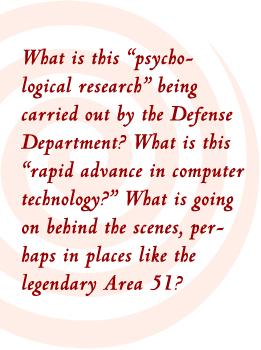



A Congressional Matter
How do we know that a stimulus is below the threshold of consciousness? By definition, we cannot know, because we cannot experience the stimulus. The only person who knows that a subliminal stimulus is present is the person who created it. So a subliminal stimulus has to be deliberately created. It requires the existence of a presenter — a person who deliberately brings such a stimulus into existence. And, if the subliminal stimulus is deliberately created, then it must be, at the same time, deliberately hidden. From there, it is not a big leap to consider the subliminal as the domain of mad scientists, science-fiction writers or unscrupulous government conspirators. This line of thinking dominates the conversation about subliminal persuasion, even at the supposed higher levels of inquiry.
On August 6, 1984, testimony was given at a hearing before the Subcommittee on Transportation, Aviation and Materials of the Committee on Science and Technology of the U.S. House of Representatives. The hearing was presided over by U.S. Rep. Dan Glickman of Kansas, chair of the subcommittee. The title of the hearing was “Subliminal Communication Technology.” Glickman’s opening remarks immediately framed the subject matter in sinister overtones: “This subcommittee has kind of made it a theme this year to explore in addition to the other areas of our jurisdiction those things which concern the public in a kind of Orwellian sense as a result of the nomenclature of this year 1984.”
Glickman cited the example of subliminal tapes and expressed concern that subliminal messages could be used to alter behavior. He said, “Clearly we need to take a closer look at the use of subliminal communication technology given the serious moral, ethical and legal implication posed by some of these recent advances.”

So-called experts testified with both excitement and alarm that subliminal messages could be used to encourage good driving or to manipulate an individual’s thoughts. Yet the “advances” referred to by Glickman and the “research” alluded to by experts simply did not and still do not rise above the level of what-if speculations. The conversation borders on the comical as the elected officials and witnesses indulge in what Glickman refers to as “twilight zone” implications. If this is the tone set by congressmen and expert witnesses, it is not surprising to find that others speak in similar terms.
The reference to “The Twilight Zone” is indicative of another side to our talk about subliminal perception. It implies that we shouldn’t take this stuff too seriously, just as we shouldn’t take the plots seen on “The Twilight Zone” too seriously. But Glickman cannot be sure it does not have some reality to it. He said, “Given the rapid advance in computer technology in this country, as well as psychological research — much of which is being done by the Defense Department — I think it is incumbent upon us in Congress to at least explore the issue to see how widespread it is and see if anything needs to be done about it.” What is this “psychological research” being carried out by the Defense Department? What is this “rapid advance in computer technology?” What is going on behind the scenes, perhaps in places like the legendary Area 51?
The Source of the Science Fiction
The path toward the realm of “The Twilight Zone” was charted immediately following Vicary’s revelations in 1957. The Wall Street Journal’s account, with its image of the “flying saucer lurking somewhere behind the scenes,” explicitly incorporates the themes of suspense and strangeness.
Additional accounts of the press conference further emphasize the science-fiction overtones. Norman Cousins wrote an oft-quoted editorial in the Saturday Review, which began as follows:
“Welcome to 1984. A new company has been formed with offices in New York for the purpose of promoting a new invention designed to get at the sources of human motivation. … The device thrusts images or messages onto a motion picture screen or TV grid. The images are invisible to the human eye. They are ‘subliminal’; that is, they are beamed into the mind below the threshold of awareness.”
The image of messages being “beamed” into the mind is reminiscent of many science-fiction motifs popular in the 1950s. The discourses which followed the Vicary press conference transform and decorate Vicary’s original presentation with a blend of images concerning the nature of the human mind and the manipulation of subconscious desire for questionable ends. This can be seen in the editorial of Cousins when he asks:
“Question: if the device is successful for putting over popcorn, why not politicians or anything else? If it is possible to prompt the subconscious into making certain judgments of human character, why wouldn’t it be possible to use invisible messages for the purpose of annihilating a reputation or promoting it?”
This trend is further exemplified in Aldous Huxley’s Brave New World Revisited, published in 1958. Huxley considered machines the method by which rulers, even in democratic societies, could destroy, control and manipulate individual freedoms while at the same time maintaining the illusion of that freedom. One method that Huxley considers is the use of “subliminal projection machines” to disperse propaganda and advertising messages. He suggests that such subliminal techniques might well become a “powerful instrument for the manipulation of unsuspecting minds” and that “The scientific dictator of tomorrow will set up his whispering machines and subliminal projectors in schools and hospitals … and in all public places where audiences can be given a preliminary softening up by suggestibility increasing oratory or rituals.”
In one year, from 1957 to 1958, subliminal persuasion had been transformed from a technique for presenting advertisements to a technique for undermining the very fabric of a free society. Vicary’s message was successful in the sense that it was persuasive, but the reaction to it was far beyond what Vicary ever expected. During the period 1957 to 1959, there was a universal condemnation of the technique and its underlying assumptions, and some called for a federal ban of such messages.

The Subliminal Projection Co., Inc. quickly went out of business. Vicary’s legacy, however, has lived on through his original characterization of subliminal persuasion being adopted in modern cultural representations. In an interview printed in Advertising Age, five years later, Vicary saw himself as having had a negligible impact on the field. He said, “All I accomplished, I guess … was to put a new word into common usage. And for a man who makes a career out of picking the right names for products and companies, I should have my head examined for using a word like subliminal.”
Vicary has done much more than introduce a new word, however. His press conference sparked an explosion of discourse about subliminal persuasion that has yet to subside. This discourse introduced the concept of subliminal persuasion to the average person and placed it into their vocabulary and understanding. Vicary’s original framing of the subliminal persuasion paradigm and its visualization in the story of the popcorn experiment has dominated the way in which the effects of subliminal messages are conceptualized, represented and spoken about in American popular culture.
FDU Magazine Home | Table of Contents | FDU Home | Alumni Home | Comments
©Copyright 2007 Fairleigh Dickinson University. All rights reserved.
For a print copy of FDU Magazine, featuring this and other stories, contact Rebecca Maxon, editor, 201-692-7024 or maxon@fdu.edu.